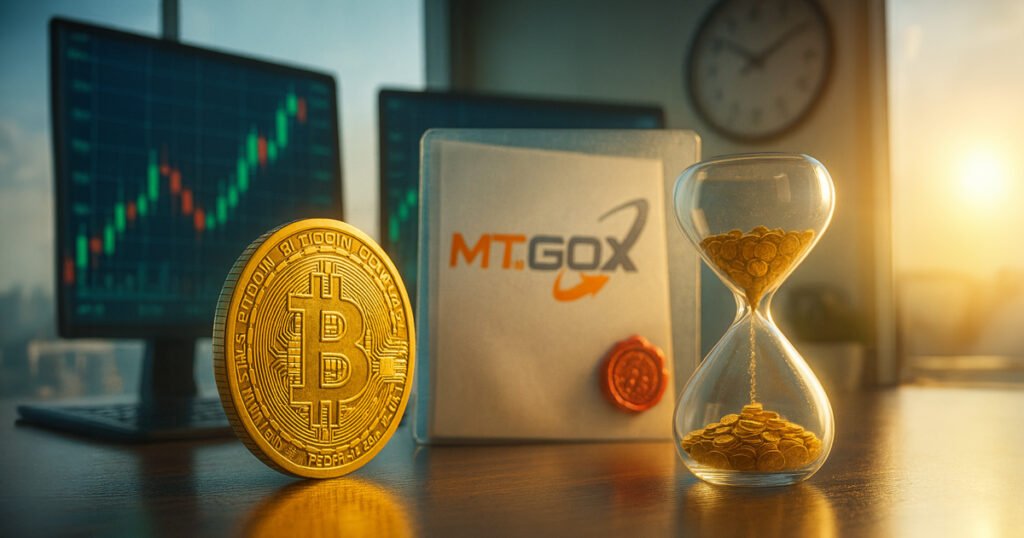The Mt. Gox Repayment Deadline Extended: Implications for Bitcoin and Crypto Markets
Introduction
The Mt. Gox saga continues as the deadline for repayments has been pushed from this Friday to October 31, 2026, following court approval. This one-year extension, while deferring immediate sell pressure, transforms what could have been a significant supply event into a protracted administrative process. The repayments, expected to trickle through exchanges and custodians rather than flood the market, suggest that the Mt. Gox distributions will not serve as a singular catalyst capable of shaking the broader crypto market structure.
Reasons for the Delay
The decision to extend the repayment timeline was driven by incomplete creditor procedures and various processing issues. The trustee indicated that base, early lump sum, and intermediate repayments, originally set to conclude by October 31, 2025, would now take an additional year. This adjustment translates a potential supply overhang into an elongated processing timeline. Historically, repayment phases revealed that payouts involve significant time delays, filtering through exchange queues and custody processes that can extend over several months. Current estimates suggest that around 34,700 BTC remain in the Mt. Gox estate, but the actual on-chain figures fluctuate amid internal movements.
Market Context and Bitcoin Demand
The backdrop for the Mt. Gox repayments unfolds against a rapidly evolving market landscape, where Bitcoin ETFs have accumulated over $61.98 billion in inflows. As of October, the net flows reached $4.2 billion. At the current Bitcoin price near $115,000, this translates to an absorption potential of approximately 36,000 BTC—roughly the entire remaining Mt. Gox inventory. This comparison not only highlights the substantial demand from regulated entities but underscores a more extensive context wherein traditional supply and demand dynamics engage in a complex interplay.
The Role of Derivatives and ETFs
As the market gears up for the eventual Mt. Gox distributions, the expansion in listed derivatives provides additional flexibility to manage episodic spot flows. According to CME Group data, crypto futures and options hit all-time highs in the third quarter, indicative of a dynamic trading environment that allows for better handling of fluctuating demand. Spot ETFs, especially BlackRock’s IBIT fund with around $89 billion in assets, create a structural buyer that didn’t exist during earlier repayment phases. These developments indicate that while Mt. Gox distributions pose a risk, they might be absorbed effectively by existing market mechanisms, reducing the risk of disorderly price movements.
Future Risks in the Crypto Market
Looking ahead, the risks associated with the Mt. Gox repayments remain tied to macroeconomic factors and critical deadlines. Tax timing can trigger concentrated selling pressure, particularly around year-end and filing deadlines in various jurisdictions. Additionally, macroeconomic influences, such as the Bank of Japan’s potential interest rate moves, could exacerbate market volatility and overshadow the significance of the Mt. Gox distributions. For instance, a funding squeeze could lead to balance sheet reductions across risk assets, affecting Bitcoin more significantly than the Mt. Gox supply adjustments.
Scenarios for Market Impact
Frameworking plausible outcomes related to the Mt. Gox overhang can be achieved through a straightforward scenario analysis. Assuming the overhang of 34,689 BTC at a price of $115,174 per coin, a variety of sale percentages can be envisioned. In a low trickle scenario, if only 25% (8,672 BTC) were sold, this would equate to around $1 billion in value. Conversely, if 80% were sold, the value could reach approximately $3.2 billion. Such scenarios highlight that the timing and manner in which these sales occur—whether they cluster around tax dates or manifest as a staggered release—will significantly influence market conditions.
Conclusion
In summary, the latest extension of the Mt. Gox repayment deadline to October 31, 2026, redistributes the timeline of supply risk within the Bitcoin market. While the immediate pressures have been alleviated, the potential impacts remain nuanced and dependent on various factors, including macroeconomic conditions, trading dynamics, and tax timelines. As Bitcoin continues to navigate this complex landscape, monitoring upcoming events and trends will be essential for understanding future market movements and dynamics. The next checkpoint lies in 2026, where both creditors and market participants will be keenly observing how this protracted repayment process unfolds.

















